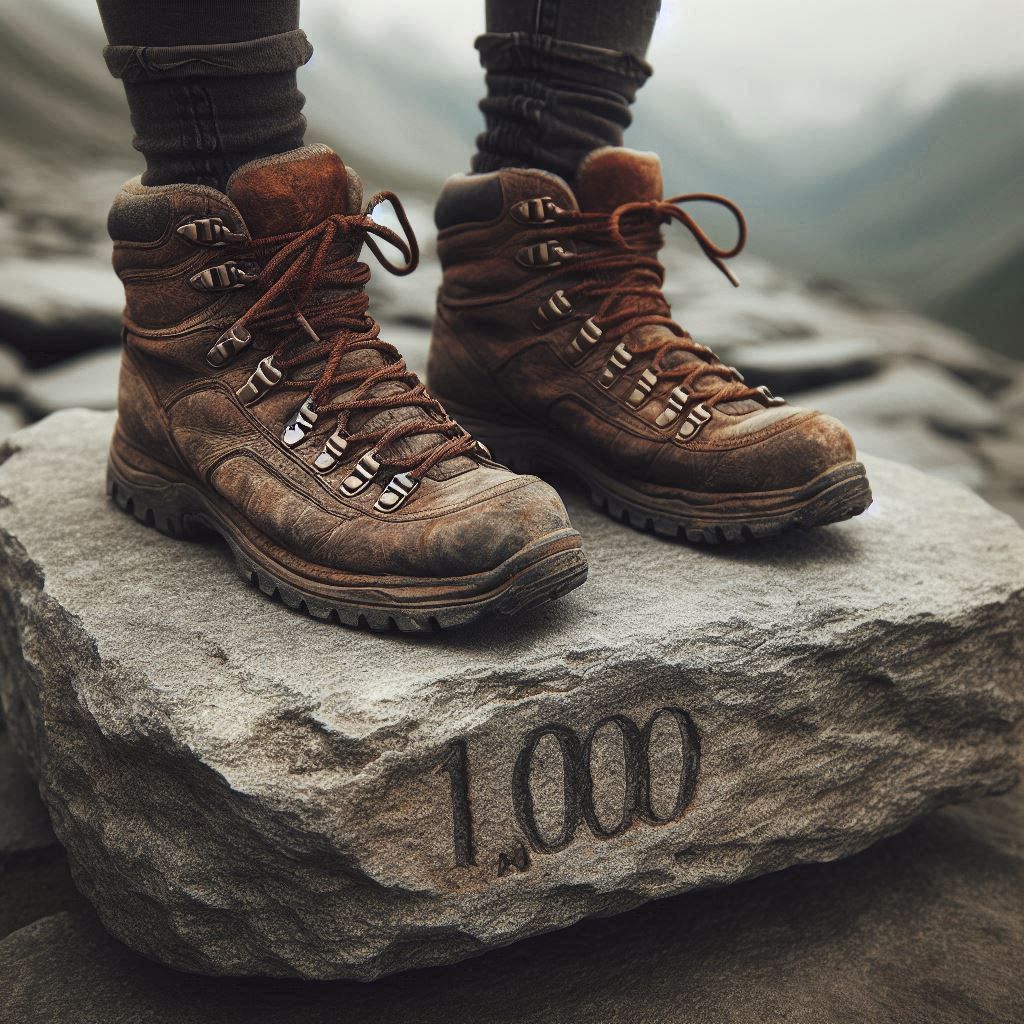One Thousand Steps
I wondered if I could walk 1,000 Steps. I had before on several occasions, but the last time I did so was two years ago. Then last March I broke my ankle, and for the entire year that followed, attempting such a taxing trudge was out of the question.
But over the months, my fibula regenerated. As evidenced by a series of x-rays, both ends of the fractured bone grew towards one another until they met in the middle and fused together. A natural phenomenon that was fascinating and uplifting to see.
Yet, although it was clear my fibula had knitted itself back to one whole bone, I was uncertain my ankle had regained its previous strength, and I wondered if I could still walk 1,000 Steps. I knew if I could, I would be satisfied. Because while there are certainly much greater feats of physical prowess, walking 1,000 Steps is about as far as I want to go.
So, off I recently went to Huntingdon County to try to walk a short portion of the eighty-five-mile Standing Stone Trail (SST) that traverses Central Pennsylvania’s ridges and valleys and is part of the Great Eastern Trail that runs from Florida to New York. The mid-section of the SST has the 1,000 Steps I hoped to hike.
Ascending Jacks Mountain through a rocky wild of craggy scree slopes where scrubby rhododendron, mountain laurel, jack pines, other conifers, and various hardwoods somehow manage to grow among countless boulders, 1,000 Steps is a steep flight of stairs made of native Tuscarora sandstone. I have never counted the steps myself, but by all accounts, there are more than a thousand, with the total ranging from 1,036 to over 1,100 depending on who is doing the counting. I can understand the discrepancies since the steps vary quite a bit in size, depth, and the vertical distance between them. All are irregular and uneven, and some are slanted. It is therefore difficult at times to distinguish between a rock meant to be a manmade step and one that Mother Nature just happened to place within the trail.
1,000 Steps from bottom to top is approximately one-half mile with an elevation gain of 850 feet. That’s fairly precipitous. For comparison, the steepest mile of the five-mile ascent up Colorado’s Mount Elbert, the tallest peak in the Rockies, has an elevation gain of 1,400 feet. In my estimation then, 1,000 Steps is a respectable climb, not to be scoffed at. I was quite pleased with myself when, with my freshly mended ankle, I reached its lofty end. Once there and as always, I was further delighted by the idyllic views of the valley below known as Jacks Narrows, a deep gorge and water gap where the graceful Juniata River nudges her way through a stately crowd of Appalachian hillsides.
Jacks Narrows is not only scenic, it is historic. Thousands of years before European colonization of Pennsylvania, running through Jacks Narrows was a footpath regularly trod by numerous indigenous tribes as a travel route through the Allegheny Mountains. By the early 1700s, European settlers and fur traders were also using the trail. They named it Kittanning, taken from the Lenape Native American word “Kithanink,” meaning “on the main river.”
One of those 18th century European fur traders was Jack Amstrong. In 1744, local legend has it he stole a horse from Mushemeelin, a Delaware Native American who Jack claimed owed him a debt. In any case, a huge mistake on Jack’s part.
Mushemeelin tracked the presumed horse thief down on Kittanning Path and murdered him in the narrow river valley that ever since has been known as Jacks Narrows. As for the mountain sweeping up from the narrows, it too was given the name Jacks. I guess there must have been a lot of sympathy, or maybe it was more like mockery for poor, dumb, foolish Jack.
Four years later, in 1748, a nineteen-year-old William Franklin, the illegitimate son of Benjamin Franklin, wandered the Kittanning Path to gather information about the American frontier and its inhabitants for his father. One of his assigned tasks was to meet, along with the heads of other indigenous tribes, the chief of the Delaware nation. I cannot help but wonder if the then still recent, bloody story of Mushemeelin and Jack Armstrong gave the young man any pause. But it must have ended okay. Because as far as I know, the Alleghenies has no Williams Narrows, and Wills Mountain in Bedford County, PA is named for a Shawnee tribesman.
Moving right along, by the early 1800s, Kittanning Path had evolved into a stagecoach turnpike road. Around the same time, in the 1820s, the Pennsylvania Main Line Canal was built to connect Philadelphia merchants with Pittsburgh and the West. It too passed through Jacks Narrows. As did the Pennsylvania Railroad when it was constructed a few decades later. Eventually, the railroad replaced the canal.
Today, the Pennsylvania Railroad is gone as well, but its tracks are still used by other rail carriers. It is not unusual to hear train whistles and the rhythmic clickety-clack of their wheels from 1,000 Steps. While the sound of vehicles going by below on the busy William Penn Highway (aka U.S. Route 22) that officially began in 1916 and still runs through Jacks Narrows can now and then be perceived as well. Yet, rarely does the traffic’s low hum rise above a hiker’s huffing and puffing. Or at least not this particular hiker’s huffing and puffing.
Along Pennsylvania’s Route 22, on the westbound side between the towns of Mount Union and Mapleton, is the parking lot for 1,000 Steps. At its easternmost end is the trailhead. One third of a mile up a gentle ascent through the woods gets a hiker to the first step. Which is where things get really interesting.
What makes 1,000 Steps a tough climb is not merely its steepness. What additionally makes the hike challenging is that extra close attention must be paid to every step taken. Not only because of the significant variances among the steps, but also because ankle twisters abound on the trail. On top of that, when wet or icy, the sandstones are dangerously slick, and when dry and warm, they are a basking haven for timber rattlesnakes. (Though timber rattlesnakes are normally shy and nonaggressive, I know of no circumstances where stepping on a rattlesnake carries zero risk.)
That’s all attention-grabbing stuff. Nonetheless, just like with Jacks Narrows, what is most interesting about 1,000 Steps is its history.
1,000 Steps was built in 1936 by the quarry workers of the Harbison-Walker Refractories Company. The refractories (aka brickyards) of Harbison-Walker were in the town of Mount Union at the eastern edge of Jacks Narrows. The Harbison-Walker quarry, known as the Ledge Quarry, was located approximately halfway up Jacks Mountain. There, laborers wielding hand tools mined Tuscarora sandstone formed from the sandy bottom of the shallow sea that covered the area hundreds of millions of years ago. A fact that is evidenced by the many Arthrophycus fossils of marine worm burrows found on Jacks Mountain.
Also known as ganister, Tuscarora sandstone is an extremely hard rock rich in crystalline quartz and therefore its chemical compound, silica. Silica, because it can withstand temperatures of up to three thousand degrees, was, and still is the main component in the refractory manufacturing of fire bricks. Silica fire bricks are prized as essential, safe, and reliable liners for the industrial furnaces and kilns of various industries, including steel, iron, glass, ceramic, and cement.
For the quarry workers of Harbison-Walker Refractories, it was not an easy way to make a living. A typical day began in the dark before dawn with a walk of some miles to the foot of Jacks Mountain. As the sun rose, the laborers climbed to their workplace. There, for twelve hours, they unearthed and smashed into manageable sizes ganister and then loaded the rocks into small railway cars called dinkeys for transport down the mountain and across the Juniata River to Mount Union’s brickyards. They did this six days a week year after year, and presumably even at night when, like other quarry workers in the United States at the time, they probably used oil and gas lamps, oil-filled flashlights, and/or electric arc lights to illuminate their work. Add to all this that since each man’s pay was dependent upon the weight of the stone he produced, on any given workday, the quarrymen were under a good deal of pressure to dig up, break apart, and load hundreds upon hundreds of pounds of rock. It is hard for me to imagine anyone having that much stamina. Especially when it takes just about all the grit I have got to walk 1,000 Steps.
Prior to 1936, to ascend Jacks Mountain, quarry workers either walked a long, zigzag trail made up of numerous switchbacks or took a shorter hike straight up the dizzying inclines of the narrow-gauge railroad used to transport the ganister. Or sometimes they would hitch a ride on the dinkeys. A dangerous thing to do. The steel dump carts were not made for passenger transport. A man could be thrown to his death as the dumper dinkeys lurched up the mountainside, and unfortunately, some were.
So, I suppose it was partly lucky that, on St. Patrick’s Day in 1936, there was a flood that wiped out the bridge that was a vital part of the principal route for getting ganister rock out of the quarry and into Mount Union. Losing the bridge greatly slowed fire brick production, but rather than laying off their quarrymen, Harbison-Walker put them to work building a shorter, easier, and safer commute up Jacks Mountain. Thus, 1,000 Steps was born.
From then on until the Ledge Quarry closed in 1952, laborers walked the steps to work. According to interview accounts of former Harbison-Walker quarrymen, they typically mounted the steps in twenty minutes. It usually takes me twice that long. Forty minutes, and I feel invincible when I take that last step. Ha!
Plus, to think that not once have I ever lugged up 1,000 Steps a single pick, shovel, drill, chisel, wedge, crowbar, or sledgehammer. Nor after I gasped and panted my way to the stairs’ top have I ever moved, pounded to pieces, hoisted, and schlepped any rocks. Nor have I ever gone back day after day after day to scale Jacks Mountain all over again. Nor have I ever considered attempting 1,000 Steps in anything other than beautiful weather or when I felt ill. All of which those men did.
And it is likely they often felt ill. Silica, a compound of silicon and oxygen, is hazardous to health. If inhaled in large quantities, it can and frequently does cause lung cancer, kidney disease, and chronic obstructive pulmonary disease (COPD). Undoubtedly, the quarrymen of Harbison-Walker, as they wielded their big, heavy-duty sledgehammers for hours on end over three hundred days a year, inhaled one hell of a lot of silica rock dust.
I do not know why, in 1936, the executives of Harbison-Walker chose not to lay off their laborers and instead had them build 1,000 Steps. I hope it was because they cared about their employees, and that might be true.
Be that as it may, because of the brutal physical demands of quarry work, it is also conceivable that, even during the Great Depression, Harbison-Walker Refractories did not have a gargantuan number of quarrier job applicants breaking down its doors. If that was indeed its predicament, the company administrators may not have wanted to risk perhaps permanently losing, at a substantial financial cost, their exceptional and extremely valuable employees. So, they came up with the creation of 1,000 Steps.
Of course, both reasons could be correct, and there might be other reasons beyond what I imagine as well. I have never walked in the shoes of the 1936 powers that be at Harbison-Walker, and consequently, I can only wonder as to why they went to such remarkable lengths to hold onto their rock breakers.
Nor have I ever walked in the shoes of those rock breakers. All I know about those quarrymen comes from my research, where the most telling fact I learned about them was that, like their fellow laborers in the brickyards below, the majority were immigrants. Several sources, including a 1993 report by the U.S. Department of the Interior, related they were primarily Eastern Europeans. I had to give a sad chuckle of derision when I got to the part of the Interior’s report that read “The sudden influx of so many people whose ways of speaking and living were literally foreign to long-term Mt. Union residents must have been disturbing . . .” The report then goes on to state that, in response to the newcomers supposedly “disturbing” Mount Union’s entrenched citizenry, Harbison-Walker Refractories tried to make the immigrants “less challenging and more controllable by uplifting them into a safe, more respectable social category.”
To my mind, it does not get any more patronizing than that. Or more absurdly intolerant either. Especially since Mount Union had been settled by immigrants less than one hundred years before.
Granted, as I already said, I did not know the immigrants of the past century who worked for Harbison-Walker. But it has been my observation that today too it is immigrants who most often take the physically tough jobs that very few American-born people are willing and able to do and that they work incredibly hard at those jobs, generally for pitifully low wages.
The example of this I have the most direct experience with comes from when I lived in Tampa, Florida. There, I observed hundreds of Hispanic immigrants. A number of those Hispanic immigrants I was lucky enough to become personally acquainted with, and I am forever grateful for them. They provided me with empathy at a time in my life when I very much needed empathy. They walked in my shoes.
The extraordinary thing about that is their living situation was so different than mine. The immigrants I am referring to worked on the backside at Tampa Bay Downs, the thoroughbred racetrack outside of Tampa in Hillsborough County. They were grooms, hot walkers, and exercise riders, the most subordinate positions in horseracing.
They were poor. They lived in grungy tack rooms where bridles, saddles, and other equipment are stored next to the horse stables. Typically, one or two boxes or bags held all their personal belongings. Most of the money they made they sent home to their families. They were always terribly homesick.
I realize horse racing is considered inhumane by many, and I won’t argue that valid point. But I will say that I never witnessed or even got wind of any of the impoverished track workers abusing a horse. Quite the contrary. From what I saw and heard, the people on the backside had a close, even tender relationship with their horses. It seemed to me that many of them could communicate with horses on a psychic level. All treated the horses under their care with affection, kindness, calm, patience, and dignity. The horses trusted them, and well they should have. For it was only some of the well-to-do owners and higher-up trainers who ever forced a horse to run that was not willing or fit, or mistreated a horse in some other way.
As for me, back then, I was married to a thoroughbred owner. My husband’s passion was horseracing, which he commonly and proudly referred to by its nickname, “The Sport of Kings.” I think he was understandably attracted to that elitist moniker because he had grown up working class, if not altogether poor. On his own since the age of sixteen, he was entirely self-made, and he had an unrelenting Midas touch.
So, we had a lot of money. A big, beautiful, expensive house on eight gorgeous acres of land in an exclusive equine community was our home. We had tons of other stuff too. I could buy anything and do anything that caught my fancy without even considering its price tag. But having all that money did not make me happy. It made me unhappy. As unhappy as the cursed Midas.
I could not find any wonder in it. All that glittering gold made me as dull as ditchwater, and I was drowning in that ditchwater. Fortunately though, before it was too late, I was rescued and went on to regain what having too much money had stolen from me.
I wish the same was true for my husband. He did not survive, and it is my belief that it was his love of money that destroyed him. Nonetheless, as I often say, in my heart and mind, he remains a good man, the loving father of my child, and one of the best friends I will ever have.
As far as being a thoroughbred owner goes, he invariably made certain his horses were well treated and that they got suitable homes after their racing days were over. He was also magnanimous to the low-level workers on the track’s backside. (Again, most of whom were immigrants.) Through its chaplaincy, he made large donations to help meet their collective needs and wants. He gave money to individuals strapped for cash and periodically brought home for dinner anywhere from one to quite a few. A couple of Decembers, he invited dozens to our house for a Christmas banquet, and they came.
He was a genuinely generous man. However, I came to comprehend that his generosity, albeit unfeigned, was also camouflage for his addiction to money. He shared his wealth, but he also could not ever get enough of it for himself. Money was his mean taskmaster, and he was its obedient slave. Which caused a whole host of problems, but to relate them here would be a needless painful invasion of our family’s privacy, so I won’t.
I never got into horseracing myself, but occasionally I would accompany my husband to the backside to schmooze, admire, pet, and feed the horses treats of one kind or another. They all had their favorite. There was even one horse who apparently thought life did not get any grander than having a sip of my beer.
Normally when I was on the backside, the workers were there, and I got to observe and interact with them a little. But it was when they visited our home for dinner, we formed real connections.
I remember those dinners with great fondness, gratitude, and wonder. I remember them that way because, though sometimes exhausting with all the cooking I did, they were ultimately fun, cheering, and inspiriting. Not once did I get even the slightest hint of an indication that those humble backsiders envied or resented our family’s overabundance of material riches. Without exception, they were gracious, helpful, and appreciative of what was, in the grand scheme of things, the tiny bit we did for them. They filled our home with fellowship, and they gifted us with their good will.
Most spoke only a bit of broken English. Yet, when dinner was over, and it was time for them to leave, they would approach me one by one, look me in the eyes, and say the three English words they all spoke perfectly, “God bless you.”
To this day, I can still hear the echoes of those immigrant blessings, and when I am feeling badly, they console and reassure me.
Finally, I remember those dinners with fondness, gratitude, and wonder because those dirt-poor, hardworking, overburdened Hispanic immigrants could have easily chosen to see me as only a rich, spoiled, American white woman without a care in the world. But it was clear to me that instead they made a much more difficult, much more humane choice and tried to look more deeply before they judged me.
I further maintain they succeeded. Despite the disadvantage of being on vastly unequal footing, they accomplished empathy. They felt my feelings as their own and perceived I was not entirely as I simply appeared. I swear those immigrants walked in my shoes. In doing so, they delivered me understanding, acceptance, comfort, and the human connection joy really is.
I wish more Americans, including myself, would follow in their footsteps and do for others and themselves what those immigrants did for themselves and me. How marvelous it would be if we the people would make it our habit to try to walk in shoes not our own. What a better world we could then build.
And the wonder of it is, all it would take is one thousand steps.

Credit: Bing Image Generator
Share this post via









